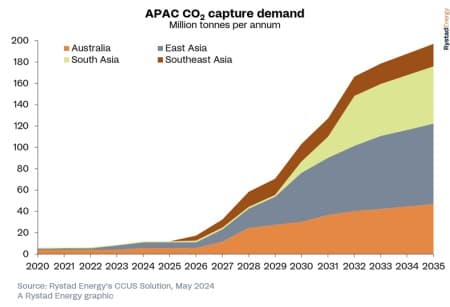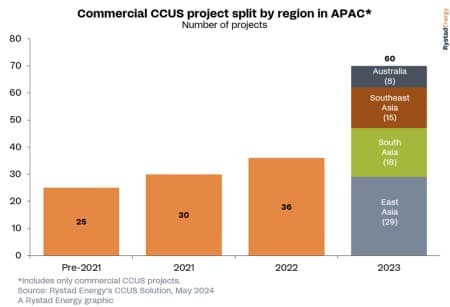The Asia Pacific (APAC) region is rapidly emerging as a key player in the carbon capture and storage (CCS) sector. Asian countries are intensifying their decarbonization efforts, despite challenges for a number of countries in the region, such as unsuitable geological conditions for carbon capture, utilization, and storage (CCUS). Rystad Energy's research highlights Australia, Malaysia, and Indonesia as emerging hubs in the APAC region, driven by the carbon dioxide (CO2) storage potential in their depleted oil and gas reservoirs and stricter environmental regulations, despite recent improvements and updates in policy. The increasing recognition of the potential of these reservoirs, combined with the urgency to reduce emissions spurring demand for CO2 storage, position the region to attract a substantial portion of the up to $15 billion in anticipated investment in CCUS across APAC, which is expected over the next decade.
Southeast Asia emerges as a promising contender in the region, offering some of the most cost-effective CO2 storage options across the APAC region. This attractiveness has prompted countries like Japan and South Korea, eager for cross-border solutions, to forge alliances with counterparts such as East Asian companies, as well as Southeast Asian and Australian players. Notable among these are Malaysia’s Petronas, Indonesia’s Pertamina, and Australian companies like Santos and Woodside Energy. This growing regional collaboration is fueled by the high population density and constrained domestic infrastructure in certain Asian nations, compelling them to explore storage solutions beyond their borders.
Momentum is already building on policies in Australia, Malaysia, and Indonesia to address regulatory gaps and pave the way for them to become key CO2 storage hubs in the region. The availability of depleted oil and gas fields, combined with ample storage capacity, infrastructure viability, and supportive regulations, further incentivizes CO2 storage initiatives in these countries.
The race is on for CO2 mitigation leadership in APAC. Policymakers are taking steps to close regulatory gaps to fully unlock the CCS value chain and create a friendly investment environment through project incentives. Ultimately, the region with the most cost-effective solutions and a clear path for CO2 storage will win. Strong government action, encompassing financing and establishing a standardized CCS framework, will also be vital.
Sohini Chatterjee, Senior Analyst, Rystad Energy.

Learn more with Rystad Energy’s CCUS Solution.
Expanding from CCS to CCUS, last year was a record-breaker in APAC, with the region adding more new projects than in any previous year. These initiatives accounted for more than half (51%) of the region's total CO2 capture capacity, surpassing the cumulative capacity of all previous years. The surge in capacity was predominantly driven by announcements from Australia, East Asia, and Southeast Asia, propelled by policies and regulations aimed at driving cross-border CCUS across the region.
East Asia spearheaded the CCUS project count, with China, South Korea, and Japan taking the lead. However, the approach to CCUS differs notably between these countries. China prioritizes the development of national projects, leveraging its abundant sub-surface reservoirs for permanent storage or enhanced oil recovery (EOR), both onshore and offshore. In contrast, South Korea and Japan focus on cross-border projects with permanent storage, in addition to their national initiatives.
Synergia Energy's Cambay CCS hub in India marks a significant development for South Asia. This project aims to capture and store CO2 emissions from nearby combined cycle gas turbine (CCGT) and coal plants in Gujarat's Cambay field. With a projected capacity of 46 million tonnes per annum (tpa), it has the potential to become the largest hub project in the Asia Pacific region. However, achieving this goal will be challenging due to limited government support for CCS initiatives and a lack of technical expertise to move beyond the research and development (R&D) stage in India.

Japan-Australia collaboration, although limited to 10 projects identified in last year's analysis, holds significant importance for the region. This is exemplified by agreements forged between Santos and Japanese entities, like JX Nippon Oil & Gas and Eneos, aiming to import up to a substantial 20 million tpa by 2040. Further highlighting Australia's importance to CO2 storage advancement in the region, Western Australia's appeal for transnational CCS endeavors is also apparent. Collaborations between Japanese companies and Australian players, such as Woodside Energy and DeepC Store, are exploring the potential capture, storage, and transportation of CO2 from Japan for injection and storage off the Western Australian coast.
Australia's commitment to carbon abatement is evident through incentives like Australian Carbon Credit Units (ACCUs) and various funding initiatives supporting CCS projects. Unlike its Asian counterparts, Australia boasts comprehensive CO2 storage regulations spanning federal Commonwealth waters, and on a provincial level in states like Queensland and Victoria. Australia's extensive CO2 storage potential is supported by stringent permitting regulations, ensuring responsible CCS project management.
Australia achieved a significant milestone for CO2 storage last year by ratifying the London Protocol, but the bill includes a key limitation. It only allows for the export of CO2, not its import. This means CO2 storage projects would still need permits and approvals under separate state or territory regulations, creating an unnecessary hurdle that partially undermines the progress.
The London Protocol, for example, shows that gaps in regulation persist in Australia, hindering cross-border CCS pathways. While financial support exists, it falls short of covering project costs, with current government funding in the range of US$10 million – $30 million. Additionally, the continent’s distance from major East Asian emitters may raise transportation costs, posing a challenge compared to regional competitors like Malaysia and Indonesia. Time will tell whether Australia, Malaysia, or Indonesia are ultimately able to lead the region in cross-border CCS, or if other key players in the region emerge.
More Top Reads From Oilprice.com:
- A Beginner's Guide to Geoengineering
- Large Crude Inventory Build Rocks Oil Prices
- OPEC Resolves Compensation Plans for Overproducing Members


















